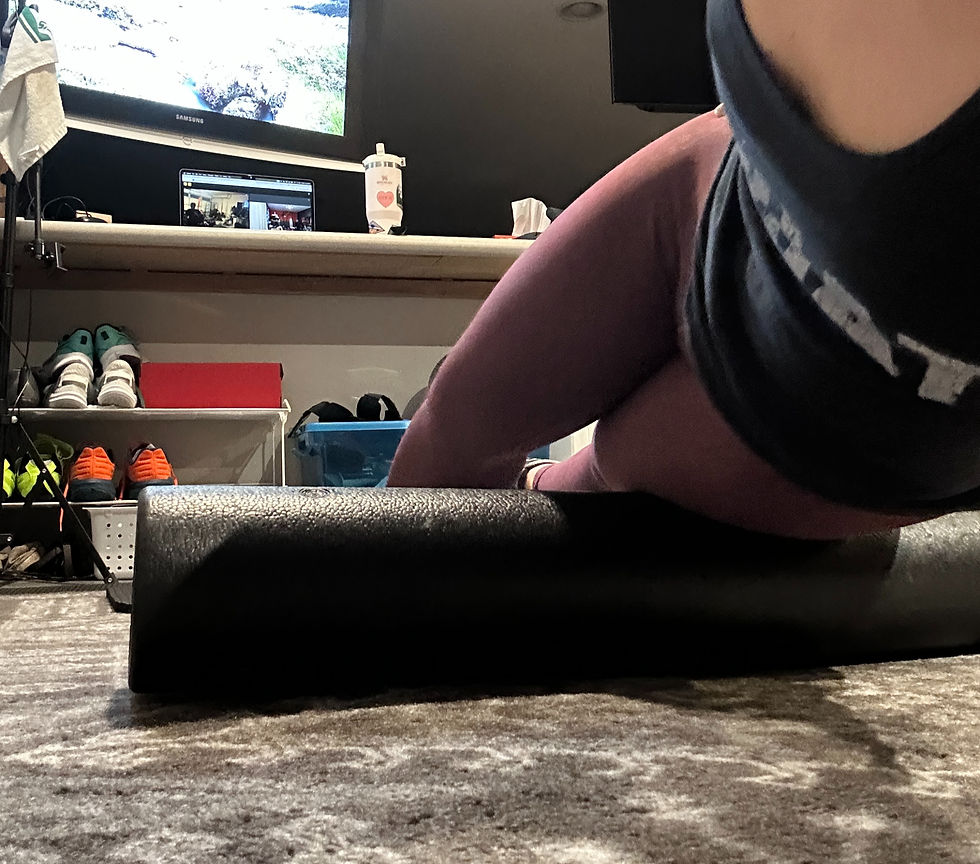Foam Rolling-- and essential tool!
- Chrissi Prom

- Mar 14
- 2 min read
The Benefits of Foam Rolling & How to Use It Effectively
As a busy mom balancing work, family, and personal wellness, taking care of your body is essential. One simple yet powerful tool that can help you stay strong, mobile, and pain-free? The foam roller! Whether you're strength training, running, or just trying to relieve tension, foam rolling is an excellent way to care for your muscles.

What Is Foam Rolling?
Foam rolling, also known as self-myofascial release (SMR), is a technique that uses a foam roller to release muscle tightness and improve mobility. Think of it as a deep tissue massage you can do yourself! It helps break up knots in your muscles and enhances blood flow, promoting faster recovery and overall muscle health.
The Benefits of Foam Rolling
Increases Flexibility & Mobility – Rolling out tight muscles can improve range of motion and help you move more freely in your workouts and daily life.
Reduces Muscle Soreness – Foam rolling before or after exercise can decrease muscle stiffness and speed up recovery, helping you stay active without discomfort.
Prevents Injury – By improving circulation and muscle elasticity, foam rolling can help prevent common injuries like strains and pulls.
Enhances Workout Performance – Loosening tight muscles before a workout can improve your performance and reduce the risk of imbalances.
Relieves Tension & Stress – Just like a massage, foam rolling can help release built-up stress and tension in your body, making it a great addition to your self-care routine.
How to Use a Foam Roller Effectively
To get the most out of foam rolling, follow these simple steps:
1. Choose the Right Foam Roller
Soft Foam Rollers – Best for beginners or those with very tight, sore muscles.
Firm Foam Rollers – Provide deeper pressure for more intense muscle release.
Textured Rollers – Great for targeting deep knots and tension.
2. Roll Slowly & Breathe
Move slowly over tight areas, pausing for 20-30 seconds on any spots that feel extra tender. Breathe deeply to help your muscles relax.
3. Focus on Key Muscle Groups
Quads & Hamstrings – Roll along the front and back of your thighs to relieve tightness.
Calves – Helps with running recovery and reduces lower leg tightness.
Glutes & Hips – Great for relieving tension from sitting or strength training.
Upper Back & Shoulders – Can reduce stiffness from poor posture or stress.
4. Don’t Overdo It
Foam rolling should be slightly uncomfortable but never painful. Avoid rolling directly over joints and bones, and spend no more than 1-2 minutes per muscle group.
When to Foam Roll
Before a Workout – To warm up muscles and increase blood flow.
After a Workout – To aid in recovery and reduce soreness.
Anytime You Feel Tight or Sore – A few minutes a day can make a big difference in how your body feels!
Final Thoughts
Foam rolling is a simple yet effective way to improve flexibility, reduce muscle soreness, and enhance overall well-being. Whether you're a runner, strength-training mom, or just someone looking to move better, adding foam rolling to your routine can help you feel stronger, looser, and ready to take on your busy day.
Have you tried foam rolling before? Let me know your favorite techniques in the comments!
.png)



Comments